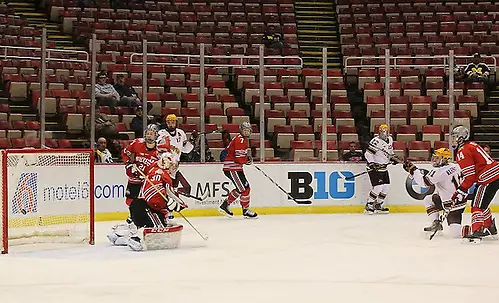
Before you see the graphic and observe that the total announced attendance for the conference tournament weekend in 2015 fell below 100,000 for the first time in the 16 years we’re looking at, stop to consider a contributing factor.
Between 2014 and 2015, two conferences changed how they ticketed their tournaments. The Big Ten went from five separate sessions, each with a single game, to three — one for each day. The WCHA ditched having separate tickets for its semifinal games in favor of a combined session.
That means there were 13 total sessions across the six conferences last weekend, down from 16 a year ago.
So while the total attendance hit another low at 97,977, the average per session was up 14 percent over last season’s rock-bottom level.
That’s not meant to gloss over the simple fact that fewer people are attending conference tournament games in the two years since the major Western conference shuffle. That’s impossible to miss, either from looking at the numbers or from watching in person or on TV.
We’ll get into that a little more after the graphic, which this year includes the per-session averages by season:
The pictures coming out of Detroit’s Joe Louis Arena, where the Big Ten had its three-day championship tournament, were not flattering, to say the least.
The attendance for this game may match yesterday’s late contest: dozens. #B1GHockey pic.twitter.com/NEAtWW3OPu
— Paula Weston (@paulacweston) March 20, 2015
That was from Friday afternoon’s Minnesota-Ohio State game. But even when the featured attraction was Michigan against Michigan State in that night’s semifinals, the announced attendance for the session was just 6,324.
Seven weeks earlier, the Wolverines and the Spartans attracted a sellout crowd of 20,027 in the same venue — granted, with much more advance notice.
The Big Ten is halfway through a four-year arrangement that has the Xcel Energy Center in St. Paul, Minn., alternating with Joe Louis Arena as host for the six-team tournament.
After averaging 8,522 in attendance in St. Paul last season, the Big Ten averaged 5,381 in Detroit.
There were more positive signs in the other five leagues in the 2015 playoff championship weekend.
The WCHA moved back to the Xcel Energy Center while the Big Ten was away and had its per-session average more than double over last season’s tournament in Grand Rapids, Mich.
At Minneapolis’ Target Center, NCHC Frozen Faceoff attendance was up nearly 3,000 per day, or 34 percent, over 2014.
Looking at both Twin Cities buildings combined, the per-session average in 2015 was 9,544 compared to 8,552 in 2014.
Still, that’s not even close to the 15,444 that the WCHA averaged over the final five seasons before the 2013 breakup sent some members to the Big Ten and NCHC and brought others in from the CCHA.
The Eastern leagues all showed growth over last season.
Hockey East’s two-day total attendance of 26,615 at Boston’s TD Garden was up 15 percent. In its second season back in Lake Placid, N.Y., ECAC Hockey’s attendance grew by 8 percent.
And in Atlantic Hockey, with Rochester Institute of Technology winning the championship in its hometown, attendance was the highest ever for the tournament. The two-day total of 7,079 was up 167 percent over last season.
In the West, there’s talk of ways of changing the tournaments to put more people in the seats of the big buildings that host the events.
In a story on WCCO-TV in Minneapolis on Sunday night, WCHA commissioner Bill Robertson said he has discussed with his NCHC counterpart, Josh Fenton, the possibility of putting their two tournaments into the same building on the same weekend.
“Might be one of the alternatives to make this much better,” Robertson told the station’s David McCoy.
The NCHC has a contract with Target Center for the next three seasons, while the WCHA again will alternate between Grand Rapids and St. Paul over the next two seasons.
In the meantime, the conferences will have to make the best of the situations they’re in. And many eyes are on the Big Ten, especially, to see how it responds to the small crowds.


